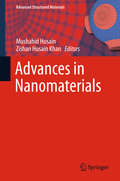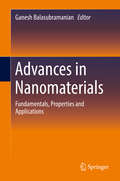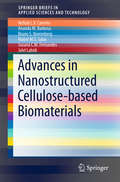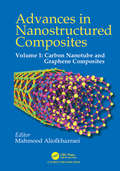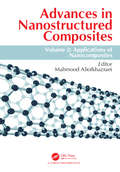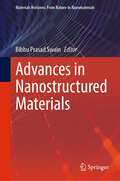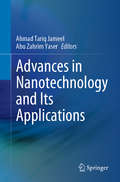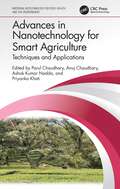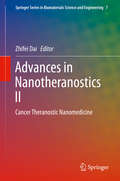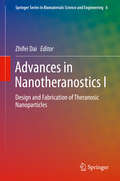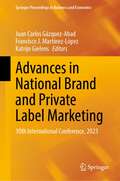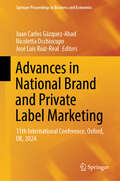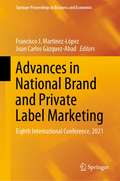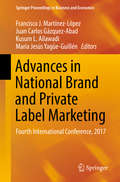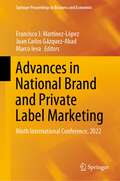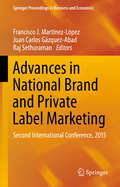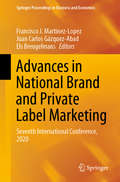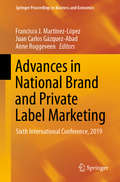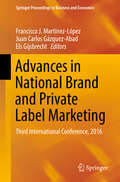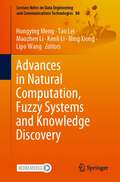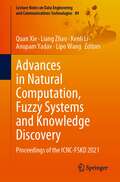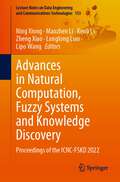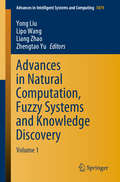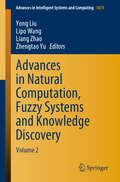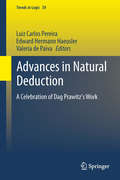- Table View
- List View
Advances in Nanomaterials: Applications (Advanced Structured Materials #79)
by Mushahid Husain Zishan Husain KhanThis book provides a review of the latest research findings and key applications in the field of nanomaterials. The book contains twelve chapters on different aspects of nanomaterials. It begins with key fundamental concepts to aid readers new to the discipline of nanomaterials, and then moves to the different types of nanomaterials studied. The book includes chapters based on the applications of nanomaterials for nano-biotechnology and solar energy. Overall, the book comprises chapters on a variety of topics on nanomaterials from expert authors across the globe. This book will appeal to researchers and professional alike, and may also be used as a reference for courses in nanomaterials.
Advances in Nanomaterials: Fundamentals, Properties and Applications
by Ganesh BalasubramanianThis exploratory textbook starts with fundamentals that satisfy the needs of a diverse group of educators, researchers and students aspiring to engage in research and engineering of nanomaterials. It bridges the gap between undergraduate students in science and engineering who have not yet chosen a specific career path, graduate students still considering different disciplines and the cross-cutting scientific topics in nanomaterials. It extends to methods of common practice in the field, spanning experimental, and theoretical techniques. The extensive use of nanomaterials, such as carbon nanotubes, in the future of global technological solutions underscores the relevance of this text aimed at students and researchers with a range of interests. "Advances in Nanomaterials: Fundamentals, Properties and Applications," is ideal for senior undergraduate and graduate students, faculty and general science enthusiasts interested in nanomaterials across contexts ranging from solar energy, structural engineering, to medical devices, to semiconductors.
Advances in Nanostructured Cellulose-based Biomaterials (SpringerBriefs in Applied Sciences and Technology)
by Neftali L. V. Carreño Ananda M. Barbosa Bruno S. Noremberg Mabel M. S. Salas Susana C. M. Fernandes Jalel LabidiThis book provides an overview of the advances on nanostructured celullose from different obtaining forms: natural plants and bacterial microorganisms. It gives the reader an introduction of cellulose focusing in nanosize particles, its potential applications and future perspectives. The potential use of cellulose in the biomedical field is highlighted.
Advances in Nanostructured Composites: Volume 1: Carbon Nanotube and Graphene Composites
by Mahmood AliofkhazraeiComposites and nanocomposites are used in cases where long durability and strength of components are required; i.e., where high stress levels, erosion processes and multiphase environments are present, including the parts under collision and impact, the parts under rotating motion and erosion (like excavation drills in oil and gas wells). The first volume of this book aims to provide a guide for fabrication of new nanocomposites mainly based on carbon nanotubes and graphene. The main topics of this volume are: Application of Nano-powders for Formation of Metal Matrix of Composites, Conjugated Polymer Nanocomposites, Biopolymer Nanocomposites, Dental Nanocomposites, Graphene-based Nanocomposites for Electrochemical Energy Storage, Polymer/Filler Composites for Optical Diffuse Reflectors, Synthesis and Applications of LDH-Based Nanocomposites, Rubber—CNT Nanocomposites, Nanocomposite Fibers with Carbon Nanotubes, Fabrications of Graphene Based Nanocomposites for Electrochemical Sensing of Drug Molecules, Recent Advances in Graphene Metal Oxide Based Nanocomposites.
Advances in Nanostructured Composites: Volume 2: Applications of Nanocomposites
by Mahmood AliofkhazraeiThe first volume of this book covered Section I: Introduction to Nanocomposites Fabrication and Section II: CNT and Graphene Nanocomposites. The present second volume covers Section III: Recent Applications of Nanocomposites. The second volume aims to provide a guide for different applications of modern nanocomposites especially those fabricated by carbon nanotubes and graphene. The book makes a comparative study of fiber-reinforced composites which have been embedded into the matrix with nanocomposites containing nanotubes in place of fibers. The main topics of this volume are: Electrochemical Properties of Nanoporous Based Materials, Fabrication and Application of Graphene Oxide-based Metal and Metal Oxide Nanocomposites, Electrochemical Sensors/Biosensors Based on Carbon Aerogels/Xerogels, Advances in Nanobiocatalysis: Strategies for Lipase Immobilization and Stabilization, Metal Oxide Based Heterojunction Nanoscale Materials for Chemiresistive Gas Sensors, Recent Advances in Polymer Nanocomposite Coatings for Corrosion Protection, Recent Advances in the Design of Nanocomposite Materials via Laser Techniques for Biomedical Applications, Carbonaceous Nanostructured Composites for Electrochemical Power Sources: Fuel Cells, Supercapacitors and Batteries, Bismuth Vanadate Based Nanostructured and Nanocomposite Photocatalyst Materials for Water Splitting Application.
Advances in Nanostructured Materials (Materials Horizons: From Nature to Nanomaterials)
by Bibhu Prasad SwainThis book presents recent advances in nanostructured materials. It describes the characterization of nanomaterials, their preparation methods and performance testing techniques; the design and development of nano-scale devices; and the applications of nanomaterials, with examples taken from different industries, such as energy, bioengineering and medicine. The book is broadly divided into sections such as nanostructure semiconductor materials for device applications, nanostructured ferroelectric and ferromagnetic materials.. The topics covered include experimental approaches of device fabrication, photovoltaics and supercapacitors applications, etc. Given the contents, the book will be useful for students, researchers, and professionals working in the area of nanotechnology and nanomaterials.
Advances in Nanotechnology and Its Applications (Springerbriefs In Applied Sciences And Technology Ser.)
by Abu Zahrim Yaser Ahmad Tariq JameelThis book highlights current trends and research advances in nanotechnology and its applications. It discusses the synthesis and characterization of nanomaterials / nanocomposites for novel applications in environmental monitoring and sustainability, and presents new findings on wastewater treatment technologies using nanofiltration membranes.
Advances in Nanotechnology for Smart Agriculture: Techniques and Applications (Microbial Biotechnology for Food, Health, and the Environment)
by Parul ChaudharyThe yield of major agricultural crops can be severely decreased due to the inappropriate application of commonly used harmful chemicals. Excessive agrochemicals in field application can negatively affect microbial populations and their diversity, which in turn ultimately affects plant growth. Thus, it is necessary to turn toward more eco-friendly approaches which equally protect crops as well as the desirable microbial populations of complex soil systems. Nanoparticles are considered as potential agents for the production and development of sustainable agriculture. Green synthesis of nanoparticles has gained attention as a useful measure to diminish the harmful effects associated with the old methods of nanoparticle synthesis. Advances in Nanotechnology for Smart Agriculture: Techniques and Applications illustrates the science and practical applications of nanoparticles for sustainable agriculture. Features: Examines the role of nanotechnology in agricultural best practices, including sustainable development, precision farming, and long-term soil health
Advances in Nanotheranostics I: Cancer Theranostic Nanomedicine (Springer Series in Biomaterials Science and Engineering #7)
by Zhifei DaiThis book highlights the recent advances in nanotheranostics from basic research to potential applications, and discusses the modular design and engineering of multiplex nanoparticles including gold nanostructures, luminescent nanoparticles, dendrimers and liposomes. Each chapter demonstrates multifunctional nanoparticles with topics covering targeting, imaging, delivery, diagnostics, and therapy as new modalities for cancer theranostics. This comprehensive book presents expert views on the latest developments in theranostic nanomedicine. It focuses on potential theranostic applications of multifunctional nanoparticles ranging from identifying noninvasively cancer cells by molecular detection, and visualizing in vivo drug delivery by means of contrast enhanced imaging, to destroying cancer cell s with minimal side effects via selective accumulation at tumor sites, and real-time monitoring therapeutic effectiveness. It also presents an interdisciplinary survey of nanotheranostics and as such is a valuable resource for researchers and students in related fields. Zhifei Dai is a Professor at the Department of Biomedical Engineering, College of Engineering, Peking University, China.
Advances in Nanotheranostics I: Design and Fabrication of Theranosic Nanoparticles (Springer Series in Biomaterials Science and Engineering #6)
by Zhifei DaiThis book highlights the recent advances in nanotheranostics from basic research to potential applications, and discusses the modular design and engineering of multiplex nanoparticles including gold nanostructures, luminescent nanoparticles, dendrimers and liposomes. Each chapter demonstrates multifunctional nanoparticles with topics covering targeting, imaging, delivery, diagnostics, and therapy as new modalities for cancer theranostics. This comprehensive book presents expert views on the latest developments in theranostic nanomedicine. It focuses on potential theranostic applications of multifunctional nanoparticles ranging from identifying noninvasively cancer cells by molecular detection, and visualizing in vivo drug delivery by means of contrast enhanced imaging, to destroying cancer cell s with minimal side effects via selective accumulation at tumor sites, and real-time monitoring therapeutic effectiveness. It also presents an interdisciplinary survey of nanotheranostics and as such is a valuable resource for researchers and students in related fields. Zhifei Dai is a Professor at the Department of Biomedical Engineering, College of Engineering, Peking University, China.
Advances in National Brand and Private Label Marketing: 10th International Conference, 2023 (Springer Proceedings in Business and Economics)
by Francisco J. Martínez-López Juan Carlos Gázquez-Abad Katrijn GielensThe 2023 International Conference on National Brand & Private Label Marketing is a unique academic forum to present and discuss original, rigorous, and significant contributions from researchers around the world on marketing issues facing retailers, store brand managers and national brand managers. The two-day event covered a wide range of topics from varied fields including retailing, marketing, general business, psychology, economics and statistics. The conference addressed diverse areas of application such as branding strategies, innovation in private labels, private label consumers, customer databases, Covid-19 consequences, loyalty programs, sustainability, and online grocery retailing, among others. A wide variety of theoretical and methodological approached have been used in these areas. This volume presents the proceedings of this 2023 NB&PL marketing conference in a collection of original, rigorous, and relevant contributions.
Advances in National Brand and Private Label Marketing: 11th International Conference, Oxford, UK, 2024 (Springer Proceedings in Business and Economics)
by Juan Carlos Gázquez-Abad Nicoletta Occhiocupo José Luis Ruiz-RealThe 2024 International Conference on National Brand & Private Label Marketing is a unique academic forum to present and discuss original, rigorous, and significant contributions from researchers around the world on marketing issues facing retailers, store brand managers and national brand managers. The three-day event covered a wide range of topics from varied fields including retailing, marketing, general business, psychology, economics, and statistics. The conference addressed diverse areas of application such as customer journey, sustainability, the metaverse, online grocery retailing, assortment branding strategies, innovation, labelling, co-creation, among others. A wide variety of theoretical and methodological approaches have been used in these areas. This volume presents the proceedings of this 2024 NB&PL marketing conference in a collection of original, rigorous, and relevant contributions.
Advances in National Brand and Private Label Marketing: Eighth International Conference, 2021 (Springer Proceedings in Business and Economics)
by Francisco J. Martínez-López Juan Carlos Gázquez-AbadThis proceedings volume highlights the latest research presented at the 8th International Conference on Research on National Brand & Private Label Marketing (NB&PL2021). The topics covered include: retailing, private label portfolio and assortment management, marketing of premium store brands, using national brands to exclude (delist) and include, optimal assortment size, consumer store patronage, etc. Several contributions also focus on private label pricing and promotion, especially on the relative pricing of standard and premium private labels, and with regard to the national brands in the assortment.
Advances in National Brand and Private Label Marketing: Fourth International Conference, 2017 (Springer Proceedings in Business and Economics)
by Francisco J. Martínez-López Juan Carlos Gázquez-Abad Kusum L. Ailawadi María Jesús Yagüe-GuillénThis book presents the latest research on national brand and private label marketing - a collection of original, rigorous and highly relevant contributions of the 2017 International Conference on National Brand & Private Label Marketing in Barcelona. It covers a wide range of topics from fields as varied as retailing, marketing, general business, psychology, economics and statistics. Further, the conference addressed diverse areas of application, including: purchase-decision models, premium private labels, decisions involved in introducing new products, M-commerce, private label adoption, assortment decisions, private label pricing, brand equity and collaborative relationships.
Advances in National Brand and Private Label Marketing: Ninth International Conference, 2022 (Springer Proceedings in Business and Economics)
by Francisco J. Martínez-López Juan Carlos Gázquez-Abad Marco IevaThis proceedings volume highlights the latest research presented at the 9th International Conference on Research on National Brand & Private Label Marketing (NB&PL2022). The topics covered include: retailing, private label portfolio and assortment management, private label pricing and promotion, national brand strategies, among other related issues. The volume specifically addresses the needs of researchers and students of advanced marketing courses.
Advances in National Brand and Private Label Marketing: Second International Conference, 2015 (Springer Proceedings in Business and Economics)
by Francisco J. Martínez-López Juan Carlos Gázquez-Abad Raj SethuramanThis book presents the latest research and recent studies in the field of national brand and private label marketing. It covers a wide range of topics, including retailing, marketing, general business, psychology, economics and statistics. It addresses diverse areas of application, such as brand naming and packaging decisions, price elasticity, positioning, branding, consumer motivation, online communities, economic crisis, strategies in growth and mature private labels. The contributions are organized according to the following themes: consumer behaviour, strategic decisions, branding, market trends and theoretical research. The book presents a collection of original, rigorous and relevant contributions from the 2015 National Brands and Private Label Marketing conference in Barcelona.
Advances in National Brand and Private Label Marketing: Seventh International Conference, 2020 (Springer Proceedings in Business and Economics)
by Juan Carlos Gázquez-Abad Francisco J. Martinez-Lopez Els BreugelmansThis proceedings volume highlights the latest research presented at the 7th International Conference on Research on National Brand & Private Label Marketing (NB&PL2020, Barcelona, Spain). The topics covered include: retailing, private label portfolio and assortment management, marketing of premium store brands, using national brands to exclude (delist) and include, optimal assortment size, consumer store patronage, etc. Several contributions also focus on private label pricing and promotion, especially on the relative pricing of standard and premium private labels, and with regard to the national brands in the assortment. Further questions addressed here include: Should store brands be promoted? If so, what types of promotion should be used? How can private label penetration, especially premium private labels, best be dealt with? Are dual branding and coupons viable options?
Advances in National Brand and Private Label Marketing: Sixth International Conference, 2019 (Springer Proceedings in Business and Economics)
by Francisco J. Martínez-López Juan Carlos Gázquez-Abad Anne RoggeveenThe 2019 International Conference on National Brand & Private Label Marketing is a unique academic forum for presenting and discussing original, rigorous and significant contributions from researchers around the world on marketing issues that retailers, store brand managers and national brand managers are facing.The three-day event covered a wide range of topics from varied fields including retailing, marketing, general business, psychology, economics and statistics. Further, it addressed diverse areas of application such as innovation, retail market structure, social media, consumer decision-making, store loyalty, assortment size, digital transformation, ethical aspects, cultural dimensions, and private label pricing. This volume gathers the proceedings of the 2019 NB&PL marketing conference in a collection of outstanding contributions that employ a wide variety of theoretical and methodological approaches.
Advances in National Brand and Private Label Marketing: Third International Conference, 2016 (Springer Proceedings in Business and Economics)
by Francisco J. Martínez-López Juan Carlos Gázquez-Abad Els GijsbrechtThis book presents the latest research on national brand and private label marketing, in the form of original, rigorous and relevant contributions from the 2016 National Brands and Private Label Marketing conference in Barcelona. It covers retailing-related topics, such as brand naming and packaging decisions, price elasticity, positioning, branding, consumer behavior, economic crisis, strategies in growth, and mature private labels.
Advances in Natural Computation, Fuzzy Systems and Knowledge Discovery (Lecture Notes on Data Engineering and Communications Technologies #88)
by Kenli Li Ning Xiong Lipo Wang Maozhen Li Hongying Meng Tao LeiThis book consists of papers on the recent progresses in the state of the art in natural computation, fuzzy systems and knowledge discovery. The book is useful for researchers, including professors, graduate students, as well as R & D staff in the industry, with a general interest in natural computation, fuzzy systems and knowledge discovery. The work printed in this book was presented at the 2020 16th International Conference on Natural Computation, Fuzzy Systems and Knowledge Discovery (ICNC-FSKD 2020), held in Xi'an, China, from 19 to 21 December 2020. All papers were rigorously peer-reviewed by experts in the areas.
Advances in Natural Computation, Fuzzy Systems and Knowledge Discovery: Proceedings of the ICNC-FSKD 2021 (Lecture Notes on Data Engineering and Communications Technologies #89)
by Anupam Yadav Liang Zhao Kenli Li Lipo Wang Quan XieThis book consists of papers on the recent progresses in the state of the art in natural computation, fuzzy systems and knowledge discovery. The book can be useful for researchers, including professors, graduate students, as well as R & D staff in the industry, with a general interest in natural computation, fuzzy systems and knowledge discovery. The work printed in this book was presented at the 2021 17th International Conference on Natural Computation, Fuzzy Systems and Knowledge Discovery (ICNC-FSKD 2021, 24–26 July 2021, Guiyang, China). All papers were rigorously peer-reviewed by experts in the areas.
Advances in Natural Computation, Fuzzy Systems and Knowledge Discovery: Proceedings of the ICNC-FSKD 2022 (Lecture Notes on Data Engineering and Communications Technologies #153)
by Kenli Li Ning Xiong Zheng Xiao Lipo Wang Maozhen Li Longlong LiaoThis book consists of papers on the recent progresses in the state of the art in natural computation, fuzzy systems, and knowledge discovery. The book is useful for researchers, including professors, graduate students, as well as R & D staff in the industry, with a general interest in natural computation, fuzzy systems, and knowledge discovery. The work printed in this book was presented at the 2022 18th International Conference on Natural Computation, Fuzzy Systems, and Knowledge Discovery (ICNC-FSKD 2022), held from 30 July to 1 August 2022, in Fuzhou, China. All papers were rigorously peer-reviewed by experts in the areas.
Advances in Natural Computation, Fuzzy Systems and Knowledge Discovery: Volume 1 (Advances in Intelligent Systems and Computing #1074)
by Yong Liu Liang Zhao Zhengtao Yu Lipo WangThis book discusses the recent advances in natural computation, fuzzy systems and knowledge discovery. Presenting selected, peer-reviewed papers from the 15th International Conference on Natural Computation, Fuzzy Systems and Knowledge Discovery (ICNC-FSKD 2019), held in Kunming, China, from 20 to 22 July 2019, it is a useful resource for researchers, including professors and graduate students, as well as R&D staff in industry.
Advances in Natural Computation, Fuzzy Systems and Knowledge Discovery: Volume 2 (Advances in Intelligent Systems and Computing #1075)
by Yong Liu Liang Zhao Zhengtao Yu Lipo WangThis book discusses the recent advances in natural computation, fuzzy systems and knowledge discovery. Presenting selected, peer-reviewed papers from the 15th International Conference on Natural Computation, Fuzzy Systems and Knowledge Discovery (ICNC-FSKD 2019), held in Kunming, China, from 20 to 22 July 2019, it is a useful resource for researchers, including professors and graduate students, as well as R&D staff in industry.
Advances in Natural Deduction: A Celebration of Dag Prawitz's Work (Trends in Logic #39)
by Luiz Carlos Pereira Edward Hermann Haeusler Valeria De PaivaThis collection of papers, celebrating the contributions of Swedish logician Dag Prawitz to Proof Theory, has been assembled from those presented at the Natural Deduction conference organized in Rio de Janeiro to honour his seminal research. Dag Prawitz's work forms the basis of intuitionistic type theory and his inversion principle constitutes the foundation of most modern accounts of proof-theoretic semantics in Logic, Linguistics and Theoretical Computer Science. The range of contributions includes material on the extension of natural deduction with higher-order rules, as opposed to higher-order connectives, and a paper discussing the application of natural deduction rules to dealing with equality in predicate calculus. The volume continues with a key chapter summarizing work on the extension of the Curry-Howard isomorphism (itself a by-product of the work on natural deduction), via methods of category theory that have been successfully applied to linear logic, as well as many other contributions from highly regarded authorities. With an illustrious group of contributors addressing a wealth of topics and applications, this volume is a valuable addition to the libraries of academics in the multiple disciplines whose development has been given added scope by the methodologies supplied by natural deduction. The volume is representative of the rich and varied directions that Prawitz work has inspired in the area of natural deduction.
